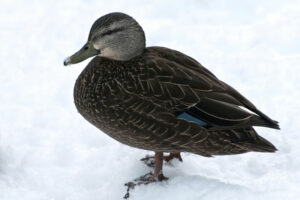 Once the most abundant fresh-water duck in eastern North America, black duck populations have dropped steadily since the 1950s, reaching all-time lows in the 1980s. Many factors have been implicated in the Black Duck’s decline. The North American Waterfowl Management Plan created the Black Duck Joint Venture (BDJV) in 1989 to help reverse the species’ decline.
Once the most abundant fresh-water duck in eastern North America, black duck populations have dropped steadily since the 1950s, reaching all-time lows in the 1980s. Many factors have been implicated in the Black Duck’s decline. The North American Waterfowl Management Plan created the Black Duck Joint Venture (BDJV) in 1989 to help reverse the species’ decline.
The mission of the BDJV is to promote and to coordinate the gathering of scientific information among Flyway Council, universities and wildlife agencies in Canada and the U.S., that is vital to ensuring sustained populations of Black Ducks and other waterfowl that share their breeding range.
The program strategy is to determine population trends, assess harvest and distribution changes, and determine important factors influencing population status and dynamics – the data that are necessary to guide black duck protection and management projects in related joint ventures under the NAWMP. This strategy focuses efforts in four areas: Surveys, Banding, Research and Evaluation.
The BDJV is made up of members from the Canadian Wildlife Service, the U.S. Fish and Wildlife Service, and State and Provincial agencies.
Important Factors in black duck declines
Habitat loss, competition with mallards, hunting, changes in nesting and brood-rearing success and many other problems have contributed to the decline of the black duck.
The relative importance of these factors is only just beginning to be understood. Fortunately, black duck populations have stabilized in recent years, and even increased in some areas, as more knowledge is gained through joint venture activities.
However, overall numbers of black ducks are still only at about half the level of the 1950s. With the continued efforts of the BDJV to obtain more comprehensive information and forge new partnerships among State, Provincial, and Federal agencies and the private sector in the U.S. and Canada, the management and restoration of the black ducks in North America can be achieved.
Surveys
Surveys are designed to provide statistically-reliable population trends of black duck and mallard breeding populations within much of their historic breeding range in eastern North America – Labrador, New Brunswick, Newfoundland, Nova Scotia, Ontario, Prince Edward Island, and Quebec in Canada; and Maine, Michigan, Minnesota, and Wisconsin in the United States. Surveys also provide valuable information on other breeding waterfowl within the survey areas. Black duck breeding populations are monitored through annual surveys on the species’ main breeding grounds.
This information is used to guide and evaluate waterfowl management in the Atlantic and Mississippi Flyways. It enables managers to plan and evaluate hunting programs, develop habitat protection and land management strategies, and play a prominent role in evaluating the progress of overall objectives of the North American Waterfowl Management Plan.
The survey program employs three techniques:
1) The helicopter survey has a rotational sampling regime that consists of 302 plots in total, with an annual sample of 151 twenty-five square kilometer plots, distributed across Bird Conservation Regions (BCRs) 8, 12 and 14. The survey is performed in the Atlantic provinces, Quebec and Ontario.
2) Fixed-wing aircraft surveys over portions of Michigan, Minnesota, Ontario, New York, Quebec, Vermont, and Wisconsin using linear transects with ground-truthing by helicopter to calculate population estimates.
3) A ground survey on Prince Edward Island to estimate black duck breeding populations (a continuation of an existing survey).
Banding
The banding program is an important element in determining the appropriate management and conservation strategies for the black duck. The BDJV Technical Committee assesses the annual harvest and survival rate data for use in the annual regulatory review process. It is also useful in ongoing efforts to consider new approaches to black duck harvest management – Adaptive Harvest Management.
Banding provides essential information on subpopulations of breeding black ducks and eastern mallards. It allows managers to assess annual survival, monitor hunting pressure, and identify breeding ground origins of specific stocks as they migrate through the Atlantic and Mississippi Flyways.
The Atlantic Flyway Eastern Cooperative Banding Agreement coordinates banding programs under the Black Duck Joint Venture throughout eastern North America. Priority species include the black duck, mallard, green-winged teal, blue-winged teal, wood duck and other dabbling ducks.
Research
While survey and banding programs are providing a better description of what’s happening to black ducks and eastern mallards, the goal of research is to understand why. The research program addresses key factors responsible for the black duck’s decline, including:
- factors influencing recruitment rates (nesting and brood-rearing success) throughout the black duck’s range.
- critical factors in habitat use and selection by breeding black ducks, with emphasis on population density and reproductive success.
- habitat management methods for important black duck breeding, migration and wintering habitats.
- patterns of mortality for populations of black ducks, including the effects of hunting, predation, and disease.
- black duck and mallard interactions across breeding, migration and wintering habitats, with emphasis on hybridization and competition.
Communication and Evaluation
The BDJV evaluation program is an important element in helping research programs helps to determine their impact on the black duck population, and to guide future efforts.
The objectives of the BDJV evaluation plan are:
- tracking progress toward objectives in the overall strategic plan.
- monitoring the black duck population in relation to North American Waterfowl Management Plan goals.
- testing the validity of assumptions made in designing survey and banding strategies.
- synthesizing research findings to determine data gaps and facilitating construction of models to test competing hypothesis.
- providing feedback on effectiveness of strategies to help revise and refine the techniques that will help meet the BDJV objectives.

